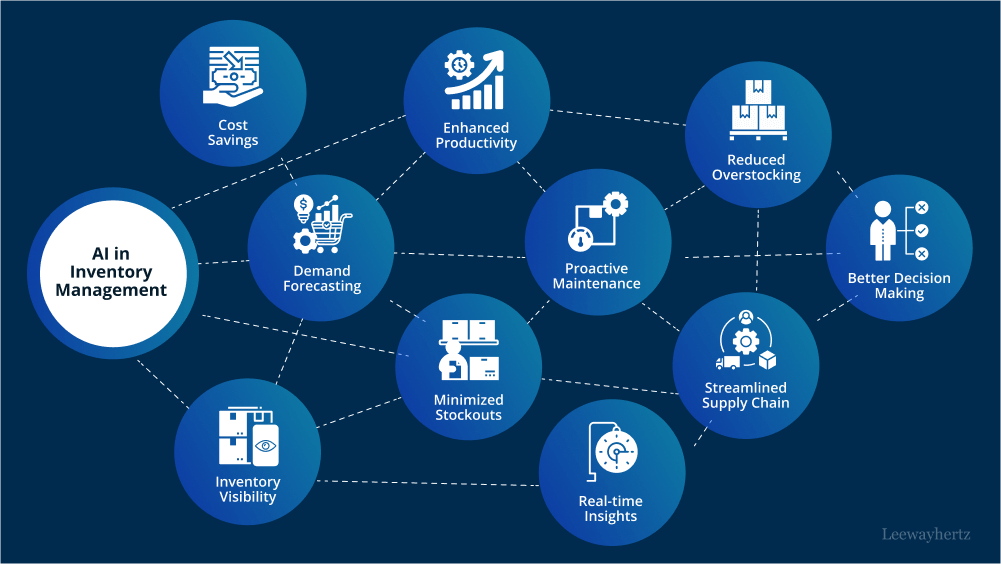How Artificial Intelligence Can Help Organizations With Inventory Management: Boost Efficiency and Accuracy
Artificial intelligence (AI) is transforming the way organizations manage their inventory. AI can optimize supply chain management and increase efficiency using predictive analytics, offering businesses precise inventory forecasting. This results in better stock levels and minimizes the risk of overstocking or stockouts.
With AI, you can benefit from real-time data on inventory, shipments, and demand trends. This technology allows you to make timely decisions that improve order fulfillment and customer satisfaction. AI not only enhances visibility across the supply chain but also builds trust by guaranteeing the traceability of products.
You can streamline operations and reduce costs by embracing AI in your inventory management processes. Implementing AI-driven tools can increase transparency and smoother workflow, making your organization more competitive in today’s fast-paced market.
Key Takeaways
- AI optimizes inventory management through predictive analytics.
- Real-time data improves order fulfillment and customer satisfaction.
- AI-driven tools enhance transparency and reduce operational costs.
Fundamentals of AI in Inventory Management
Artificial Intelligence (AI) transforms how organizations manage their inventory by introducing automation, improving efficiency, and predicting future trends. These advancements help businesses reduce costs and optimize stock levels.
Defining AI and Its Capabilities
AI refers to machines and software that can perform tasks that usually require human intelligence. These tasks include learning, reasoning, problem-solving, and decision-making. In inventory management, AI can process vast amounts of data to identify patterns, make predictions, and suggest actions.
AI systems can automate repetitive tasks, like stock replenishment, and provide detailed insights into inventory levels. They enhance their capabilities with machine learning, natural language processing, and computer vision.
The Role of AI in Modern Inventory Systems
Modern inventory systems leverage AI to boost efficiency and accuracy. AI algorithms can monitor and analyze data from various sources, such as sales records, supplier schedules, and market trends. This allows for real-time tracking and inventory management.
For instance, you can automate stock replenishment with AI, ensuring you always have the right amount of stock. Additionally, AI helps detect anomalies and reduce human error, saving costs and improving service levels.
Understanding Predictive Analytics
Predictive analytics uses statistical algorithms and machine learning techniques to forecast future events. Inventory management helps you anticipate demand, manage stock levels, and plan for supply chain disruptions.
By analyzing historical data, AI can predict which products will be in demand and when. This ensures you are better prepared for market changes and can reduce the risk of overstocking or stockouts. Predictive analytics also helps identify trends, enabling strategic decision-making aligning with business goals.
Implementation Strategies
To effectively improve your inventory management, you need a clear plan for AI. Focus on integrating AI with your current systems, collecting and analyzing data, and ensuring your staff is trained for the changes.
Integrating AI With Existing Inventory Frameworks
Integration is key. Start by evaluating your current inventory management systems. Look for areas where AI can add the most value. Compatibility is crucial, so choose AI solutions that easily connect with your existing software.
Consider starting with small, manageable projects. Use these to identify potential bottlenecks and solve integration issues early on.
You may need to work closely with IT specialists. They can ensure a smooth transition and help maintain system integrity. Ongoing support will be necessary to address any troubleshooting or technical challenges.
Data Collection and Analysis
Effective AI relies on quality data. Begin by auditing your existing data collection methods. Identify the data types you need, such as sales figures, inventory levels, and supplier information.
Implement robust data collection tools. Make sure these tools are accurate and regularly updated.
Once your data is in order, use AI for analysis. This can involve predictive analytics to forecast demand and optimize stock levels. Analyzing trends will help you identify inefficiencies and areas for improvement.
Regular audits of your data are essential. This ensures data consistency and reliability, which are critical for AI’s effectiveness.
Staff Training and Change Management
Introducing AI means changes for your team. They must understand how AI systems work and how to use them effectively. Start with comprehensive training programs.
Practical workshops can help staff get hands-on experience. Provide ongoing support and resources, such as manuals and help desks, to assist with common issues.
Communication is vital. Keep an open dialogue about the benefits of AI and address any concerns early. This helps in gaining staff buy-in and reduces resistance to change.
Prepare for an adjustment period. It takes time for staff to adapt to new systems, so patience and continuous training are key.
Remember, maintaining a positive attitude toward AI integration can significantly help smooth transitions and obtain the desired improvements.

Case Studies and Success Stories
Major advancements in AI have significantly impacted inventory management across various industries, enhancing efficiency and accuracy.
Retail Industry Breakthroughs
In retail, AI is transforming how businesses manage inventory. Netflix is at the forefront of this, using AI to personalize user experiences by recommending content based on individual viewing habits. Although primarily entertainment-focused, this serves as an example of AI’s potential for extensive data analysis.
Walmart, another key player, employs AI for stock predictions. By analyzing customer purchase data and trends, Walmart optimizes inventory levels, reducing costs and improving customer satisfaction. This predictive ability ensures the right products are available at the right times, mitigating the risks of overstocking or understocking.
Macy’s integrates AI to enhance supply chain processes. Macy’s can adjust orders dynamically through automated systems, responding quickly to changing demand.
Manufacturing Sector Innovations
AI’s role in the manufacturing sector is equally transformative. Siemens leverages AI to optimize its production flow. Using machine learning, Siemens predicts equipment failures before they occur, reducing downtime and enhancing productivity. This predictive maintenance is a game-changer for keeping operations smooth.
Toyota uses AI for just-in-time (JIT) inventory management. By forecasting demand more accurately, Toyota ensures materials arrive exactly when needed, minimizing storage costs and waste. JIT systems improve the overall efficiency of their production lines significantly.
Foxconn, a major electronics manufacturer, implements AI to manage its vast inventory. AI allows Foxconn to track parts in real time, ensuring that production schedules are met without delays.
Impact on Supply Chain Optimization
AI enhances supply chain management by providing detailed insights into every facet of the process. Amazon utilizes AI for warehouse automation. AI-powered robots streamline the sorting and packing process, speeding up delivery times and reducing errors.
Unilever uses AI to optimize its supply chain network. By forecasting demand and adjusting supply chain operations in real-time, Unilever reduces waste and meets customer demand more effectively. This adaptive approach keeps the supply chain resilient against market fluctuations.
Procter & Gamble uses AI for demand planning and logistics. AI algorithms predict the best routes for distribution, cutting down on transportation costs and improving delivery efficiency. This ensures products are available where and when needed, bolstering customer satisfaction.
Challenges and Considerations
Integrating AI into inventory management requires addressing key challenges like privacy and security, cost-benefit issues, and technical and operational hurdles. Understanding these factors ensures more effective and secure AI deployment in your inventory systems.
Addressing Privacy and Security Concerns
Implementing AI can raise privacy and security concerns. AI systems often need access to large amounts of data, including sensitive information about customers, suppliers, and internal operations. Protecting this data from unauthorized access and breaches is crucial.
Establish strict data governance policies. Encrypting data and regularly updating your security systems can help prevent cyberattacks. Additionally, compliance with regulations like GDPR (General Data Protection Regulation) or CCPA (California Consumer Privacy Act) is important to avoid legal issues.
Regular audits and security assessments can help identify vulnerabilities. Training employees to recognize potential security threats can also enhance overall security. Investing in robust cybersecurity ensures your AI-driven inventory management system remains secure and trustworthy.
Evaluating Cost-Benefit Considerations
Before adopting AI for inventory management, you must evaluate the costs and benefits. Implementing AI systems can be expensive. Costs may include software, hardware, and ongoing maintenance. Skilled personnel are also needed to manage and operate these systems.
However, AI can bring significant benefits. It can optimize stock levels, reduce waste, and improve accuracy in demand forecasting. These advantages can lead to cost savings and increased efficiency. Conducting a cost-benefit analysis helps in making an informed decision.
Weighing the initial investment against potential savings and benefits is crucial. Sometimes, the long-term savings and efficiencies justify the upfront costs. Make sure to also consider the scalability of AI solutions to meet future growth and demand.
Overcoming Technical and Operational Hurdles
Integrating AI into inventory management can create technical and operational challenges. AI systems may require significant changes to existing processes, and infrastructure upgrades might be necessary to handle new technology requirements.
You may face difficulties in data integration. AI systems need clean, accurate, and well-structured data to function effectively. Ensuring data quality and consistency across different sources can be complex.
Training employees to use AI tools is essential. Employees need to understand how to leverage AI insights effectively. Providing adequate training and support helps in smooth adoption. Collaborating with AI experts or consultants can also mitigate some technical challenges.
Planning and continuous monitoring are key to overcoming these hurdles. Testing and gradually implementing AI solutions can help identify and resolve issues early.
Addressing privacy and security, cost-benefit considerations, and technical challenges can help you integrate AI into your inventory management system successfully.



